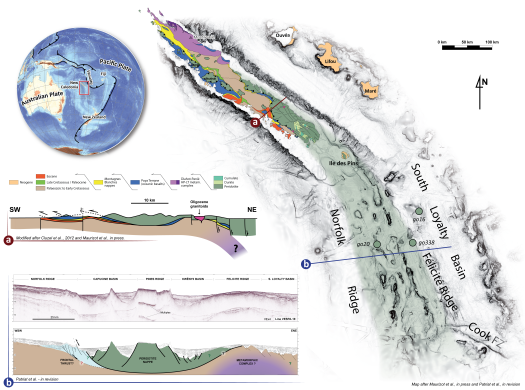The scientific analyses of the wealth of marine data recently acquired in the Western Pacific and Tasman Sea regions as part of EEZ exploratory programs (France/New Caledonia, New Zealand and Australia) have reinvigorated the debate around the geodynamic evolution of Zealandia. This evolution, from the Gondwana break-up during the Cretaceous to the subduction-dominated tectonics in the Cenozoic, led to the obduction of a string of peridotite massifs marking the eastern limits of Zealandia, from Southern New Zealand to the Papuan Ultramafic Belt Ophiolite. Amongst these, the best exposed and most extensively researched is the New Caledonian Ophiolite which has been explored and mined for mineral resources, mainly Nickel and Cobalt, for more than a century.

Fig. 1 Geological map and 2 cross sections of New Caledonia and its southern offshore extension; in green the onshore & offshore New Caledonian Peritotite Nappe and in purple the HP/LT metamorphic complex; (after Patriat et al., 2018, Tectonics). See full details: CLERC-et-al_2017_AGUposter
The New Caledonian Ophiolite exposes one of the largest obducted peridotite massifs in the world: its present-day topography exceeds 1.6 km, it makes up a quarter of the 500×80 km island of Grande Terre and stretches offshore over more than 400 km (Fig 1). This massive mantle nappe was tectonically emplaced onto the north-eastern edge of the Zealandia continent during the Eocene. The on-shore exposures are weakly deformed and structurally not imbricated within an orogenic belt. An Eocene HP/LT eclogitic metamorphic complex is found at its northeastern boundary. Obduction may also have triggered the formation of the world’s second largest rimmed carbonate platform (Miocene to Quaternary). The offshore continuation of the allochthon has been identified to the South of New Caledonia in 2000 m water-depth by seismic imaging (Fig. 1). In this area, the peridotite nappe occurs as a flat-topped continuous body, capped by carbonate reefs. It is bounded by major normal faults, and lies within a 150 km wavelength depression associated to a set of sedimentary archives (Patriat et al., 2018). East of the off-shore peridotite nappe, the 350 km long Felicité Ridge is interpreted as the southern extension of the HP/LT metamorphic complex observed onland. West of the nappe is the Norfolk Ridge along which compressional deformation is observed.
At the same time as new marine data were bringing new insights on the geodynamic evolution of Zealandia, the growing environmental concerns related to terrestrial mining in New Caledonia led local institutions and mining companies to fund new research to develop tools to study the ophiolite and, in particular, to understand the alteration processes taking place in the peridotites as well as their potential to achieve carbon capture and storage via in situ mineral carbonation (e.g. “Expertise on CO2 Storage in peridotites” CNRT Nickel 2013). In June 2017, the participants of the Australasian IODP Regional Planning Workshop (Sydney, Australia) identified several unresolved fundamental questions relating to ophiolite emplacement, to exchanges between solid Earth and its external envelopes and to the deep biosphere, all defined in the IODP 2013-2023 Science Plan, that could be addressed by drilling the New Caledonian Ophiolite and its offshore extension:
- Earth Connections (theme 1): The emplacement mechanisms of mantle-dominated allochthons and their relations with underlying exhumed HP metamorphic units are still debated. These mechanisms could be addressed by deep drilling the ultramafic sequence and associated sedimentary records, metamorphic sole and underlying basement (IODP Challenge 8 & 11). The contractional phase which led to obduction of the ophiolite is contemporaneous with the initiation of the Tonga-Kermadec subduction (primary focus of expedition IODP 371). What are the relationships between these two outstanding tectonic processes? (IODP Challenge 11) The available geochemistry also indicates that regionally the peridotites of New Caledonia have a highly depleted chemistry. What causes this depletion? (IODP Challenge 8)
- Earth in Motion and Biosphere Frontiers (theme 2): Several alteration processes are observed onshore throughout the massifs and are associated with serpentinization, fracturation, flow and transport in fractured peridotitic basement aquifers. They involve carbon trapping, methane and hydrogen-rich fluid production, volatile and metal fluxes (IODP Challenges 11, 13, 14) and abiotic vs biotic processes. Archaeal and eubacterial communities are known to develop in these alkaline systems which could have several similarities with hydrothermal environments at the beginning of life on Earth (IODP Challenge 5, 6, 7).
- Climate and Ocean Change (theme 3): carbonate reefs that overlie the allochthon are one of the world’s largest rimmed platform. What is the age of their formation and their relation to other Pacific reefs? Was their initiation associated with climate changes? What is the contribution of ultramafic alteration-derived fluids on the carbonate reef development? (IODP Challenges 1, 2)
Finally, significant discrepancies exist between geological records, phylogenetic evolution and biogeography. Indeed, endemism of New Caledonia and New Zealand biota are thought to be inherited from Gondwana, whereas current studies of geological records indicate deep sea environments were prevalent during the Paleocene and Eocene. Refining paleogeography and identifying land gateways would help resolve this major issue.
Drilling through an Amphibious Drilling Proposal would allow to understand an obducted geological system from its pre-obduction mantle history to its obduction onto a continental extended margin and subsequent geodynamic, bio-geochemical evolution.

